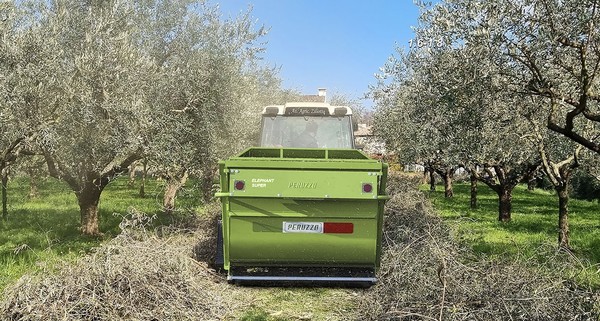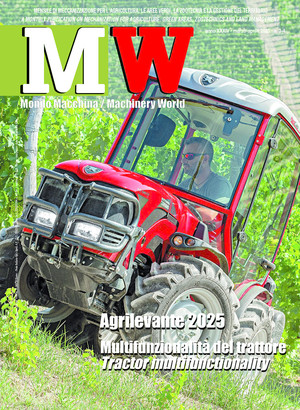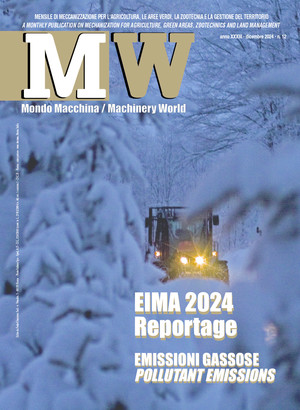
Pruning residues management
From waste or refuse to by product. From a disposal burden to a resource, through energy recovery via combustion, in chips or pellets. This is the positive transformation of pruning residues, which has led to the development of dedicated mechanization chains
The energy transition represents the shift from a system based on fossil fuels to one based on renewable, sustainable energies with low environmental impact. This process is supported by a growing ecological awareness, which is pushing individuals, businesses, and governments to adopt more responsible behaviors. In this context, the circular economy emerges as a virtuous model, whose fundamental principles are summarized in the 4 Rs motto: "Reduce, Repair, Reuse, Recycle."
Even in the agricultural world, waste has long since ceased to exist: it is all by-products, and as such, their management should no longer be a burden (not only economic), but rather a resource from which to derive profit, or at least benefits for the ecosystem, the environment, and the community.
With this in mind, pruning residues from woody crops have also seen a proliferation of opportunities for reuse, and with them the flourishing of equipment, or even mechanization chains, specifically dedicated to this purpose.
The following is a review, undoubtedly brief and incomplete, of the various possibilities available today, focusing in particular on the management of vine shoots, i.e., vine pruning residues.
Shredding in the field. This is the traditional option, preferable when it is necessary to replenish soil depleted of organic matter due to repeated intensive cultivation. The vine shoot shredder is a piece of equipment carried or sometimes semi-carried by the tractor, generally connected to the 3-point hitch and powered by the power take-off, equipped with a rotor fitted with Y-shaped blades or, more frequently, hammers, for the simultaneous shredding of pruning residues and/or any grass present. The working width usually varies from just under one meter to 2.2 m. Some models may include retractable side devices to intercept the vine shoots lying in the under-row and convey them to the machine's transit area. However, it is important to assess the phytosanitary status of the vine shoots in advance: in the presence of wood diseases (such as esca disease, see box), shredding could promote the spread of the pathogen, thus making it necessary to remove the infected material.
In this case, there are several options available for collecting and treating vine shoots, bearing in mind that this is a by-product that has recently been put to good use, especially in the 'wood-energy' supply chain (see box).
Chipping and collection in the field. One option is to collect pruning residues, duly chipped, in breathable fabric bags, suitable for natural drying of the material, to be used for combustion for energy purposes. In this context, Nobili di Molinella (BO) offers models from the TRP-RT range of shredders, connected to the tractor's 3-point hitch and semi-mounted with the aid of a roller or ground support wheels. The machines are equipped with a suitable pick-up (465 mm in diameter) which rotates at up to 140 rpm and selectively lifts the vine shoot fragments, excluding grass, stones, and soil. The shredding rotor, also 465 mm in diameter, rotates at 2,600 rpm and is equipped with 14 to 24 hammers, depending on the working width, which varies between approximately 1.2 and 1.7 m in the various versions. The engine power of the coupled tractor increases accordingly, from 70 to 130 Hp. The matching fabric bags have a volume of 0.8 m³, for a typical capacity of 200 kg of material. The manufacturer claims a working capacity of between 0.5 and 1 ha/h. The use of bags is advantageous for the correct drying of the material: if stored away from atmospheric precipitation, the fermentation process of fresh wood chips stops on the fourth day, thus preserving the harvest from rotting. Under suitable conditions, the relative humidity gradually decreases from approximately 50% to less than 10% in just over a month.
As an alternative to energy production through combustion, wood chips can be a valuable aid in compost production. In this case, the shredded material can be stored in a container on board and then unloaded in a suitable location. Many manufacturers offer such options; for example, Dragone in Castagnole Lanze (AT) markets the AB series, which can be fitted with knives or hammers and offers different models with working widths ranging from 130 to 280 cm, making them suitable for vineyards and orchards. The harvested and shredded product is unloaded through a large rear door, which is hydraulically operated. An additional option is to unload the shredded material onto a trailer pulled behind the machine, or onto another tractor coupled to the mulcher. This solution is offered by several manufacturers, including Berti in Caldiero (VR), which markets the Picker R series, with models ranging from 140 to 180 cm in working width, suitable for shredding woody material up to 80 mm in diameter. The conveyor has a triangular gooseneck shape with a hydraulically adjustable discharge chute.
It is also possible to deposit the wood chips on the ground under the rows to create effective mulch that helps to combat weed growth and maintain higher surface soil moisture. For this purpose, Nobili offers the TRP-CL range, which creates a double flow of material deposited in swaths in the desired areas, using mechanically or hydraulically adjustable conveyor ducts.
Baling in the field. The removal of vine shoots for energy purposes can also be carried out with the material as it is, by baling. Compared to chipping in the field, this can have two advantages: it promotes the natural drying of the wood, thanks to the better aeration of the baled bales, and it offers different options for subsequent treatment. On the other hand, the volumes to be managed are significantly higher. In any case, the machines used are balers, in some cases suitably reinforced for the proper handling of woody material, which has a much higher mechanical resistance than hay. Among others, Lerda di Busca (CN) offers models suitable for this purpose, for prismatic bale sizes ranging from 32x42 cm to 36x46 cm. In particular, Lerda states that its prismatic balers can achieve a minimum packaging length of 30 cm, which is suitable for introducing the bales into all the fireboxes of the various boilers dedicated to this purpose.
Energy supply chain. Having access to a complete mechanization supply chain, specifically dedicated to the energy recovery of pruning residues, greatly facilitates the effective exploitation of this by-product. This is what CAEB International from Petosino di Sorisole (BG) has accomplished, which not only manufactures machines for collecting canes, both tractor-mounted and self-propelled, but also offers stationary chippers, pelletizers, and finally boilers for the combustion of woody material. For field harvesting, CAEB International offers the Quickpower towed round baler, which produces bales measuring 40 cm in diameter and 60 cm in length, weighing approximately 25-30 kg. An interesting feature is the bale conveyor that can be mounted on top of the machine, which allows temporary storage of up to 8 bales on board, so that they can be unloaded at the headland, thus significantly reducing the time needed to transport them to the farm center, where the bales, after a suitable period of natural drying, can be shredded into 20-50 mm fragments in a fixed-point chipper, operated by the tractor's PTO.
Alternatively, for the production of wood chips and high working capacities, the self-propelled EdiChipper model is available which, thanks to a 120 Hp diesel engine, shreds the product directly in the field, then loads it on board into a 4 m³ container equipped with a hydraulic discharge. The machine has a productivity of up to 4,000 kg/h of pruning residues and can also work on vineyards and orchards planted on sloping ground, up to a gradient of approximately 35%.
To complete the offer, CAEB International also provides a plant dedicated to the transformation into Ø 6 mm pellets, with a productivity of approximately 100 kg/h.
Esca disease
This is a disease that particularly affects vines, caused by a group of fungi that colonize the lymphatic vessels, impairing the translocation of water and nutrients to the aerial part of the plant, causing it to wither and die. It mainly occurs following wounds, especially on the stump, which provide access routes for the spores of the pathogenic fungi. Unfortunately, this disease is widespread in all wine-growing areas of the world and is especially associated with old vineyards. Recently, however, the disease has also appeared in young vineyards with increasing spread and intensity, especially on varieties considered sensitive.
As is almost always the case, prevention is the best cure, such as maintaining the right balance in the soil microbiota to increase the plants' ability to resist new infections, avoiding water stagnation, applying Trichoderma-based products that make it difficult for the pathogen to take root, eliminating diseased plants, carefully removing pruning residues, and paying close attention to the disinfection of work tools and equipment if moving from diseased plants to healthy plants.
It is therefore strongly advised not to shred vine shoots, as it has been shown that even one-year-old infected wood can spread the disease; in this case, it is useful to collect the residues and burn them for energy.
The energy valorization of vine shoots
The well-known concept of the "circular economy," i.e., minimizing waste and reusing any by-products, can also be profitably applied to the management of vine pruning residues.
When, for various reasons, it is not feasible to shred the vines in the field to return organic matter to the soil, the vine shoots can be collected and used for energy recovery, mainly through combustion and the resulting production of heat, which can be used to heat buildings and produce hot water for operational or purely sanitary purposes.
Vine shoots, and more generally woody residues from tree pruning, can be used to produce wood chips or densified into pellets and briquettes and burned in suitable plants, i.e., equipped with the technical measures to correctly manage the high ash content.
Dried vine wood chips with 25-35% moisture content have a lower calorific value (therefore without recovery of the heat contained in the exhaust fumes), generally varying between 3.0 and 3.5 kWh/kg, which is lower than that of straw (4.25 kWh/kg), for example, but also lower than that of coniferous wood (4.7-5.0 kWh/kg).
The quantity of vine shoots that can be obtained at harvest (with a moisture content of 40-50%) obviously depends on the variety, the type of cultivation, and pruning practices, but in general, it can be estimated at between 20 and 60 q/ha per year, with an estimated average in Italy of approximately 32 q/ha per year. This is therefore a significant resource, such that it can be usefully considered as a viable solution, especially if an equipped contractor is used for its management, avoiding the costly purchase of dedicated machinery.
Specifically for vine shoots, however, particular attention must be paid to the correct management of combustion residues, because ashes represent 4-5% of the dry matter, compared to values ranging between 0.5 and 2% for wood of forest origin.
In addition, the levels of nitrogen and copper in the ashes from vine pruning are higher than the average values found in untreated wood; this is a peculiarity attributable to fertilization and, above all, to phytosanitary treatments, especially in organic farming. To reduce the environmental impact of exhaust fumes, various types of filters are used (often installed in combination for greater effectiveness): cyclone filters to separate the heaviest particles; bag or electrostatic filters for particulate matter and fine dust; and activated carbon filters to absorb odors and harmful gases.








